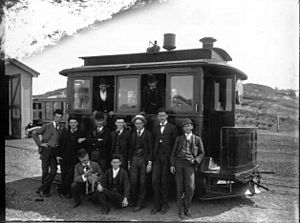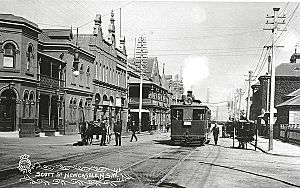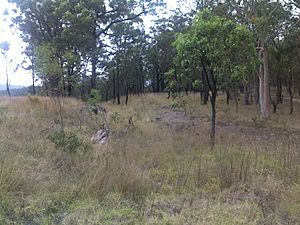Trams in Newcastle, New South Wales facts for kids
The Newcastle Tram System was a big network of trams that ran in Newcastle, Australia. It connected the city to places like Wallsend. The trams operated from 1887 until 1950. At its busiest, the lines reached as far as Speers Point and West Wallsend. The tram service often didn't make money. People started using buses more because they were easier. This led to the tram system closing down and the tracks being taken away.
Contents
The Story of Newcastle Trams
Early Days: Steam Trams
Steam trams started running in Newcastle on July 6, 1887. The very first trip was a test run between Newcastle and Plattsburg.
At first, the tram depot was at Hunter and Perkins Streets. A depot is like a garage for trams. In 1893, the tram line was made longer, going east to Parnell Place. A new, bigger depot was built there. The old depot was still used for small repairs.
Electric Trams Arrive
Trams became electric in the early 1920s. The first electric tram ran in October 1923. By the end of 1926, almost all lines were electric. Only the West Wallsend and Speers Point lines stayed steam-powered until they closed.
Because electric trams were coming, a new depot was built in Gordon Street, Hamilton. This started in 1918. The old Hunter Street and Parnell Place depots closed in 1927. All tram operations moved to the Hamilton Depot. At its biggest, the tram network had 35 miles of track.
Why the Trams Stopped
In the 1930s, fewer people rode the trams. Buses were also becoming popular and cheaper. People realized the trams were losing money. During the Great Depression, leaders didn't want to close the trams because they gave people jobs and cheap travel. But by the late 1930s, things changed. The Port Waratah and Carrington lines closed in 1938.
World War II stopped more closures for a while. Fuel was limited, so buses couldn't run where trams were. The Parnell Place tram stop was damaged when the Japanese shelled Newcastle on June 8, 1942. After the war, more lines closed. The Mayfield line closed in 1948, the Wallsend line in 1949, and the rest in 1950. The very last tram ran on June 11, 1950, on the Waratah line. As trams stopped, the Hamilton Depot became a bus depot. It is still used for buses today by Newcastle Transport.
Where the Trams Went
Adamstown Line
This line opened on August 13, 1900. Electric trams started running to Adamstown on February 2, 1925. The line was made longer to Victoria Street just three months before other lines closed. There were plans to extend it further, but this never happened. The Adamstown line closed on April 17, 1950.
Carrington Line
The idea for the Carrington line came up in 1901. But it didn't start until September 23, 1912. There were problems with how the line would cross a railway track. These problems were fixed by 1912. Electric trams started on August 15, 1926. The Carrington and Port Waratah lines were the first electric lines to close. They stopped running on November 19, 1938.
Glebe Line
This line was first called the Merewether line. Its name changed to Glebe when the line to Merewether Beach was finished. It opened on April 19, 1894. It became electric in 1924, with the first electric tram running on November 2, 1924. This line closed on February 26, 1950.
Mayfield Line
Work on the line to Mayfield started in June 1892. This included building a bridge over Throsby Creek. The line opened on April 19, 1893. It was the first line in Newcastle to become electric, opening on December 15, 1923. Plans to extend this line further never happened. The Mayfield line closed on September 26, 1948.
Merewether Line
This line started on November 3, 1902. It was first called Merewether Beach. The name changed to Merewether when the Glebe line changed its name. This line became electric on July 27, 1924. It closed on February 26, 1950.
Port Waratah Line
Service started on July 20, 1914. This line was first called Maryville. It was later extended and renamed Port Waratah. It was also often called Steelworks. The line became electric on October 11, 1926. Like the Carrington line, it closed on November 19, 1938.
Racecourse Line
The first trams ran on this line on April 27, 1907. This line had a special loop for trams waiting for people going to races. The first electric tram ran on November 14, 1925. Both steam and electric trams ran for a while. The line closed on April 10, 1950.
Speers Point Line
This line was added to the West Wallsend line. It started on January 15, 1912. It was never made electric. The last regular steam trams ran on November 1, 1930. A few special trips happened after that.
Wallsend/Plattsburg Line
The Wallsend line was the very first tram line in Newcastle. It connected Newcastle to many suburbs like Hamilton, Broadmeadow, Lambton, Jesmond, Plattsburg, and Wallsend. The first trams ran on July 19, 1887. It slowly became electric from 1924. The first fully electric tram to Wallsend ran on December 26, 1925. This line closed on November 7, 1949.
Waratah Line
This was the last tram line to be finished. It opened on January 20, 1915. Regular electric trams started on April 6, 1925. When this line closed on June 10, 1950, it meant all tram services in Newcastle had stopped.
West Wallsend Line
A branch line from Wallsend to West Wallsend was built in 1910. The first tram ran on September 19. A small depot was built at Wallsend for this line. It was never made electric because it was losing money. This line had several accidents. It closed on November 1, 1930.
Tram Types and Vehicles
At first, Newcastle used double-decker trams from Sydney. But because of low bridges, the top decks had to be removed. This meant fewer people could ride. These trams were not very popular and were removed by 1896.
Steam locomotives were also used. These engines pulled special trailers called C1 and C2 Class. One engine could pull up to four trailers. Six electric cars from Sydney were also used as trailers. Other vehicles included trailers for carrying materials, water, and even a hearse car for funerals.
Newcastle also used 98 L/P-type Trams that came from Sydney during the electric tram years. Some C-type Trams were also kept for electric operations.
What's Left Today
Even though all the tracks are gone, you can still find signs of the old tram system. There are some cuttings (paths dug into hills) and causeways (raised roads) that the trams used. The cycleway through Jesmond Park is a clear example. It follows the old Wallsend Tram path and includes a cutting through Lambton Hill.
There's also a cycleway between Wallsend and Glendale. This path follows the old Wallsend to West Wallsend Tram line. It's great for cyclists because the tram lines needed a gentle slope.
Tramcar LP284
The Newcastle Museum has an old tramcar, LP284. It was moved to the museum for restoration and is now on display.
Trams Return to Newcastle
In February 2019, the Newcastle Light Rail line opened. This new light rail connects Newcastle East with Newcastle Interchange. It's part of a plan to make the city center better. It replaced the old heavy rail line.






